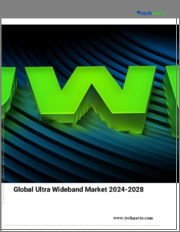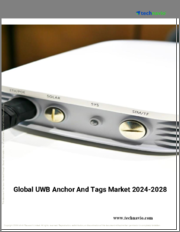
|
시장보고서
상품코드
1554123
초광대역(UWB) 시장 규모, 점유율, 동향 분석 보고서 : 용도별, 측위 시스템별, 최종 용도별, 지역별, 부문별 예측(2024-2030년)Ultra Wideband Market Size, Share & Trends Analysis Report By Application (RTLS, Imaging), By Positioning System (Indoor, Outdoor), By End-use (Residencial, Manufacturing), By Region, And Segment Forecasts, 2024 - 2030 |
||||||
초광대역(UWB) 시장 규모 및 동향:
초광대역(UWB) 세계 시장 규모는 2023년 14억 달러로 추정되며, 2024년부터 2030년까지 연평균 18.9%의 성장률을 보일 것으로 예상됩니다.
시장 성장의 배경에는 헬스케어, 자동차, 가전 등 다양한 산업에서 정확한 위치 추적 및 실시간 데이터 전송에 대한 수요가 증가하고, IoT 기기 및 스마트 인프라 프로젝트의 확산으로 다른 무선 기술에 비해 정확도가 높고 전력 소모가 적은 초광대역(UWB) 기술의 채택이 크게 증가하고 있습니다. 초광대역(UWB) 기술의 채택을 크게 촉진하고 있습니다. 또한, 비접촉식 결제 및 보안 액세스 시스템의 증가 추세는 보안 기능이 강화된 UWB를 선호하면서 시장을 더욱 촉진하고 있습니다.
UWB 기술은 빠르게 발전하고 있으며, 정확도, 통신 거리 및 전력 효율 향상에 중점을 두고 있습니다. 중요한 트렌드 중 하나는 UWB 칩의 소형화로 웨어러블 및 IoT 센서와 같은 소형 장치에 통합할 수 있게 되었다는 점입니다. 또한 UWB와 다른 기술과의 융합도 주목받고 있습니다. 예를 들어, UWB와 BLE(Bluetooth Low Energy)를 결합하여 장치 검색 및 페어링 프로세스를 강화할 수 있습니다. 또한 UWB를 인공지능(AI) 및 머신러닝(ML) 알고리즘과 통합하면 위치 예측 및 상황별 서비스를 향상시킬 수 있습니다.
이러한 소형화는 저전력 설계의 발전과 함께 UWB 지원 기기의 배터리 수명을 연장하고 있으며, 초광대역(UWB) 기술의 발전은 블루투스 및 Wi-Fi와 같은 다른 무선 통신 표준과의 상호 운용성 향상으로 두드러지게 나타나고 있습니다. 이러한 상호운용성은 UWB 애플리케이션의 범용성을 높이고 기존 통신 네트워크에 원활하게 통합할 수 있게 해줍니다. 또한 UWB 안테나와 신호 처리 알고리즘의 발전으로 UWB 시스템의 통신 거리, 정확도 및 신뢰성이 향상되어 스마트홈 오토메이션에서 정밀 농업에 이르기까지 더욱 광범위한 응용 분야에서 UWB 시스템을 매력적으로 만들고 있습니다.
규제 동향은 UWB 시장 상황을 형성하는 데 중요한 역할을 하고 있습니다. 전 세계 정부와 규제 기관은 UWB 기술의 잠재력을 점점 더 많이 인식하고 있으며, 안전하고 효율적인 배포를 보장하기 위한 가이드라인을 수립하고 있습니다. 미국 연방통신위원회(FCC)는 UWB를 위한 특정 주파수 대역을 할당하여 상용 애플리케이션에 대한 채택을 촉진하고 있습니다. 마찬가지로 유럽전기통신표준화기구(ETSI)는 유럽 전역에 걸쳐 UWB 기술 표준화를 통해 UWB 기술의 사용을 촉진하기 위해 노력하고 있습니다. 이러한 규제 당국의 노력은 초광대역 기술의 성장과 상용화를 위한 환경을 조성하는 데 있어 매우 중요합니다.
그러나 다른 무선 통신 기술에 비해 초광대역 기술의 높은 비용은 특히 비용에 민감한 시장에서 UWB의 채택을 방해하고 있습니다. 또한, 초광대역 시스템의 복잡한 특성으로 인해 도입 및 유지보수에 상당한 전문 지식이 필요하기 때문에 중소기업이나 기술 자원이 제한된 기업에게는 장벽이 될 수 있습니다. 다른 무선 기술과의 간섭과 엄격한 규제 기준을 준수해야 하는 것도 초광대역 시스템의 원활한 구축과 운영을 보장하기 위해 해결해야 할 과제입니다.
목차
제1장 조사 방법과 범위
제2장 주요 요약
제3장 시장 변수, 동향, 범위
- 시장 소개/계통 전망
- 업계 밸류체인 분석
- 시장 역학
- 시장 성장 촉진요인의 영향 분석
- 시장 과제의 영향 분석
- 시장 기회의 영향 분석
- 초광대역(UWB) 시장 분석 툴
- Porters 분석
- PESTEL 분석
제4장 초광대역(UWB) 시장 : 용도별 추정·동향 분석
- 부문 대시보드
- 초광대역(UWB) 시장 : 용도 변동 분석, 2023년 및 2030년
- 실시간 위치추적 시스템(RTLS)
- 매출 추정과 예측, 2018-2030년
- 이미징
- 매출 추정과 예측, 2018-2030년
- 통신
- 매출 추정과 예측, 2018-2030년
제5장 초광대역(UWB) 시장 : 측위 시스템별 추정·동향 분석
- 부문 대시보드
- 초광대역(UWB) 시장 : 측위 시스템 변동 분석, 2023년 및 2030년
- 실내 측위 시스템
- 야외 측위 시스템
제6장 초광대역(UWB) 시장 : 최종 용도 업계별 추정·동향 분석
- 부문 대시보드
- 초광대역(UWB) 시장 : 최종 용도 업계 변동 분석, 2023년 및 2030년
- 주택
- 자동차·수송
- 제조업
- 가전
- 기타
제7장 초광대역(UWB) 시장 : 지역별 추정·동향 분석
- 초광대역(UWB) 시장 점유율, 지역별, 2023년 및 2030년
- 북미
- 북미 초광대역(UWB) 시장 추정과 예측, 2018-2030년
- 미국
- 캐나다
- 멕시코
- 유럽
- 유럽의 초광대역(UWB) 시장 추정과 예측, 2018-2030년
- 영국
- 독일
- 프랑스
- 아시아태평양
- 아시아태평양의 초광대역(UWB) 시장 추정과 예측, 2018-2030년
- 중국
- 인도
- 일본
- 한국
- 호주
- 라틴아메리카
- 라틴아메리카의 초광대역(UWB) 시장 추정과 예측, 2018-2030년
- 브라질
- 중동 및 아프리카
- 중동 및 아프리카의 초광대역(UWB) 시장 추정과 예측, 2018-2030년
- 사우디아라비아(KSA)
- 아랍에미리트
- 남아프리카공화국
제8장 경쟁 상황
- 기업 분류
- 진출 기업 개요
- Qorvo Inc.
- NXP Semiconductors
- Inpixon
- Texas Instruments Incorporated
- Apple, Inc.
- Samsung Electronics Co., Ltd.
- nanotron Technologies GmbH
- Fractus SA
- Humatics Corporation
- Johanson Technology Inc.
- 기업의 시장 포지셔닝
- 기업 시장 점유율 분석, 2023년
- 기업 히트맵 분석
- 전략 매핑
- 확대
- 협업
- 인수합병
- 신제품 발매
- 파트너십
- 기타
Ultra-wideband Market Size & Trends:
The global ultra wideband market size was estimated at USD 1.40 billion in 2023 and is expected to grow at a CAGR of 18.9% from 2024 to 2030. The market growth is attributed to several factors, such as increasing demand for precise location tracking and real-time data transmission in various industries such as healthcare, automotive, and consumer electronics. The proliferation of IoT devices and smart infrastructure projects is significantly boosting the adoption of ultra wideband (UWB) technology, as it offers superior accuracy and low power consumption compared to other wireless technologies. In addition, the rising trend of contactless payments and secure access systems is further propelling the market, with UWB being a preferred choice due to its enhanced security features.
UWB technology rapidly evolves and focuses on improving accuracy, range, and power efficiency. One significant trend is the miniaturization of UWB chips, enabling their integration into smaller devices such as wearables and IoT sensors. In addition, the convergence of UBW with other technologies is also gaining traction. For instance, combining UWB with Bluetooth Low Energy (BLE) enhances device discovery and pairing processes. Furthermore, integrating UWB with artificial intelligence (AI) and machine learning (ML) algorithms improves location prediction and context-aware services.
This miniaturization is coupled with advancements in low-power designs, extending battery life in UWB-enabled devices. The evolution of ultra wideband technology is also marked by its growing interoperability with other wireless communication standards such as Bluetooth and Wi-Fi. This interoperability enhances the versatility of UWB applications, allowing seamless integration into existing communication networks. Furthermore, advancements in UWB antennas and signal processing algorithms improve the range, accuracy, and reliability of UWB systems, making them more attractive for a wider range of applications, from smart home automation to precision agriculture.
Regulatory trends are playing a significant role in shaping the UWB market landscape. Governments and regulatory bodies across the globe are increasingly recognizing the potential of UWB technology and are establishing guidelines to ensure its safe and efficient deployment. The Federal Communications Commission (FCC) has allocated specific frequency bands for UWB use in the United States, facilitating its adoption in commercial applications. Similarly, the European Telecommunications Standards Institute (ETSI) has been working on standardizing UWB technology to promote widespread usage across Europe. These regulatory efforts are crucial in creating a conducive environment for the growth and commercialization of ultra wideband technology.
However, compared to other wireless communication technologies, the high cost of ultra wideband technology is hindering the adoption of UWB, especially in cost-sensitive markets. Moreover, the complex nature of ultra wideband systems requires significant expertise in deployment and maintenance, which can be a barrier for smaller companies or those with limited technical resources. Interference with other wireless technologies and the need to comply with stringent regulatory standards also pose challenges that must be addressed to ensure the smooth deployment and operation of ultra wideband systems.
Global Ultra Wideband Market Report Segmentation
The report forecasts revenue growth at global, regional, and country levels and provides an analysis of the latest industry trends in each of the sub-segments from 2018 to 2030. For this study, Grand View Research has segmented the global ultra wideband market report based on application, positioning system, end-use, and region:
- Application Outlook (Revenue, USD Million, 2018 - 2030)
- Real-time Location System (RTLS)
- Imaging
- Communication
- Positioning System Outlook (Revenue, USD Million, 2018 - 2030)
- Indoor Positioning System
- Outdoor Positioning System
- End Use Outlook (Revenue, USD Million, 2018 - 2030)
- Residential
- Automotive & Transportation
- Manufacturing
- Consumer Electronics
- Others
- Regional Outlook (Revenue, USD Million, 2018 - 2030)
- North America
- U.S.
- Canada
- Mexico
- Europe
- Germany
- UK
- France
- Asia Pacific
- China
- India
- Japan
- South Korea
- Australia
- Latin America
- Brazil
- Middle East & Africa (MEA)
- UAE
- Kingdom of Saudi Arabia (KSA)
- South Africa
Table of Contents
Chapter 1. Methodology and Scope
- 1.1. Market Segmentation & Scope
- 1.2. Market Definitions
- 1.3. Research Methodology
- 1.3.1. Information Procurement
- 1.3.2. Information or Data Analysis
- 1.3.3. Market Formulation & Data Visualization
- 1.3.4. Data Validation & Publishing
- 1.4. Research Scope and Assumptions
- 1.4.1. List of Data Sources
Chapter 2. Executive Summary
- 2.1. Market Outlook
- 2.2. Segmental Outlook
- 2.3. Competitive Landscape Snapshot
Chapter 3. Market Variables, Trends, and Scope
- 3.1. Market Introduction/Lineage Outlook
- 3.2. Industry Value Chain Analysis
- 3.3. Market Dynamics
- 3.3.1. Market Driver Impact Analysis
- 3.3.2. Market Challenge Impact Analysis
- 3.3.3. Market Opportunity Impact Analysis
- 3.4. Ultra Wideband Market Analysis Tools
- 3.4.1. Porter's Analysis
- 3.4.1.1. Bargaining power of the suppliers
- 3.4.1.2. Bargaining power of the buyers
- 3.4.1.3. Threats of substitution
- 3.4.1.4. Threats from new entrants
- 3.4.1.5. Competitive rivalry
- 3.4.2. PESTEL Analysis
- 3.4.2.1. Political landscape
- 3.4.2.2. Economic and Social landscape
- 3.4.2.3. Technological landscape
- 3.4.2.4. Environmental landscape
- 3.4.2.5. Legal landscape
- 3.4.1. Porter's Analysis
Chapter 4. Ultra Wideband Market: Application Estimates & Trend Analysis
- 4.1. Segment Dashboard
- 4.2. Ultra Wideband Market: Application Movement Analysis, 2023 & 2030 (USD Million)
- 4.3. Real-time Location System (RTLS)
- 4.3.1. Real-time Location System (RTLS) Revenue Estimates and Forecasts, 2018 - 2030 (USD Million)
- 4.4. Imaging
- 4.4.1. Imaging Revenue Estimates and Forecasts, 2018 - 2030 (USD Million)
- 4.5. Communication
- 4.5.1. Communication Revenue Estimates and Forecasts, 2018 - 2030 (USD Million)
Chapter 5. Ultra Wideband Market: Positioning System Estimates & Trend Analysis
- 5.1. Segment Dashboard
- 5.2. Ultra Wideband Market: Positioning System Movement Analysis, 2023 & 2030 (USD Million)
- 5.3. Indoor Positioning System
- 5.3.1. Indoor Positioning System Market Revenue Estimates and Forecasts, 2018 - 2030 (USD Million)
- 5.4. Outdoor Positioning System
- 5.4.1. Outdoor Positioning System Market Revenue Estimates and Forecasts, 2018 - 2030 (USD Million)
Chapter 6. Ultra Wideband Market: End Use Vertical Estimates & Trend Analysis
- 6.1. Segment Dashboard
- 6.2. Ultra Wideband Market: End Use Vertical Movement Analysis, 2023 & 2030 (USD Million)
- 6.3. Residential
- 6.3.1. Residential Market Revenue Estimates and Forecasts, 2018 - 2030 (USD Million)
- 6.4. Automotive & Transportation
- 6.4.1. Automotive & Transportation Revenue Estimates and Forecasts, 2018 - 2030 (USD Million)
- 6.5. Manufacturing
- 6.5.1. Manufacturing Revenue Estimates and Forecasts, 2018 - 2030 (USD Million)
- 6.6. Consumer Electronics
- 6.6.1. Consumer Electronics Revenue Estimates and Forecasts, 2018 - 2030 (USD Million)
- 6.7. Others
- 6.7.1. Others Revenue Estimates and Forecasts, 2018 - 2030 (USD Million)
Chapter 7. Ultra Wideband Market: Regional Estimates & Trend Analysis
- 7.1. Ultra Wideband Market Share, By Region, 2023 & 2030 (USD Million)
- 7.2. North America
- 7.2.1. North America Ultra Wideband Market estimates & forecasts, 2018 - 2030 (USD Million)
- 7.2.2. U.S.
- 7.2.2.1. U.S. Ultra Wideband Market estimates & forecasts, 2018 - 2030 (USD Million)
- 7.2.3. Canada
- 7.2.3.1. Canada Ultra Wideband Market estimates & forecasts, 2018 - 2030 (USD Million)
- 7.2.4. Mexico
- 7.2.4.1. Mexico Ultra Wideband Market estimates & forecasts, 2018 - 2030 (USD Million)
- 7.3. Europe
- 7.3.1. Europe Ultra Wideband Market estimates & forecasts, 2018 - 2030 (USD Million)
- 7.3.2. UK
- 7.3.2.1. UK Ultra Wideband Market estimates & forecasts, 2018 - 2030 (USD Million)
- 7.3.3. Germany
- 7.3.3.1. Germany Ultra Wideband Market estimates & forecasts, 2018 - 2030 (USD Million)
- 7.3.4. France
- 7.3.4.1. France Ultra Wideband Market estimates & forecasts, 2018 - 2030 (USD Million)
- 7.4. Asia Pacific
- 7.4.1. Asia Pacific Ultra Wideband Market estimates & forecasts, 2018 - 2030 (USD Million)
- 7.4.2. China
- 7.4.2.1. China Ultra Wideband Market estimates & forecasts, 2018 - 2030 (USD Million)
- 7.4.3. India
- 7.4.3.1. India Ultra Wideband Market estimates & forecasts, 2018 - 2030 (USD Million)
- 7.4.4. Japan
- 7.4.4.1. Japan Ultra Wideband Market estimates & forecasts, 2018 - 2030 (USD Million)
- 7.4.5. South Korea
- 7.4.5.1. South Korea Ultra Wideband Market estimates & forecasts, 2018 - 2030 (USD Million)
- 7.4.6. Australia
- 7.4.6.1. Australia Ultra Wideband Market estimates & forecasts, 2018 - 2030 (USD Million)
- 7.5. Latin America
- 7.5.1. Latin America Ultra Wideband Market estimates & forecasts, 2018 - 2030 (USD Million)
- 7.5.2. Brazil
- 7.5.2.1. Brazil Ultra Wideband Market estimates & forecasts, 2018 - 2030 (USD Million)
- 7.6. Middle East & Africa
- 7.6.1. Middle East & Africa Ultra Wideband Market estimates & forecasts, 2018 - 2030 (USD Million)
- 7.6.2. The Kingdom of Saudi Arabia (KSA)
- 7.6.2.1. The Kingdom of Saudi Arabia (KSA) Ultra Wideband Market estimates & forecasts, 2018 - 2030 (USD Million)
- 7.6.3. UAE
- 7.6.3.1. UAE Ultra Wideband Market estimates & forecasts, 2018 - 2030 (USD Million)
- 7.6.4. South Arica
- 7.6.4.1. South Africa Ultra Wideband Market estimates & forecasts, 2018 - 2030 (USD Million)
Chapter 8. Competitive Landscape
- 8.1. Company Categorization
- 8.2. Participant's Overview
- 8.2.1. Qorvo Inc.
- 8.2.1.1. Participant's Overview
- 8.2.1.2. Financial Performance
- 8.2.1.3. Product Benchmarking
- 8.2.1.4. Recent Developments
- 8.2.2. NXP Semiconductors
- 8.2.2.1. Participant's Overview
- 8.2.2.2. Financial Performance
- 8.2.2.3. Product Benchmarking
- 8.2.2.4. Recent Developments
- 8.2.3. Inpixon
- 8.2.3.1. Participant's Overview
- 8.2.3.2. Financial Performance
- 8.2.3.3. Product Benchmarking
- 8.2.3.4. Recent Developments
- 8.2.4. Texas Instruments Incorporated
- 8.2.4.1. Participant's Overview
- 8.2.4.2. Financial Performance
- 8.2.4.3. Product Benchmarking
- 8.2.4.4. Recent Developments
- 8.2.5. Apple, Inc.
- 8.2.5.1. Participant's Overview
- 8.2.5.2. Financial Performance
- 8.2.5.3. Product Benchmarking
- 8.2.5.4. Recent Developments
- 8.2.6. Samsung Electronics Co., Ltd.
- 8.2.6.1. Participant's Overview
- 8.2.6.2. Financial Performance
- 8.2.6.3. Product Benchmarking
- 8.2.6.4. Recent Developments
- 8.2.7. nanotron Technologies GmbH
- 8.2.7.1. Participant's Overview
- 8.2.7.2. Financial Performance
- 8.2.7.3. Product Benchmarking
- 8.2.7.4. Recent Developments
- 8.2.8. Fractus S.A.
- 8.2.8.1. Participant's Overview
- 8.2.8.2. Financial Performance
- 8.2.8.3. Product Benchmarking
- 8.2.8.4. Recent Developments
- 8.2.9. Humatics Corporation
- 8.2.9.1. Participant's Overview
- 8.2.9.2. Financial Performance
- 8.2.9.3. Product Benchmarking
- 8.2.9.4. Recent Developments
- 8.2.10. Johanson Technology Inc.
- 8.2.10.1. Participant's Overview
- 8.2.10.2. Financial Performance
- 8.2.10.3. Product Benchmarking
- 8.2.10.4. Recent Developments
- 8.2.1. Qorvo Inc.
- 8.3. Company Market Positioning
- 8.4. Company Market Share Analysis, 2023
- 8.5. Company Heat Map Analysis
- 8.6. Strategy Mapping
- 8.6.1. Expansion
- 8.6.2. Collaborations
- 8.6.3. Mergers & Acquisitions
- 8.6.4. New Product Launches
- 8.6.5. Partnerships
- 8.6.6. Others
(주말 및 공휴일 제외)


















